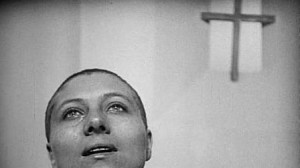
Passion of Joan of Arc
Can you imagine a movie comprised almost entirely of close-ups? Would you feel claustrophobic? Want to shove your elbows outward to create some breathing room? Stand up and stretch and take huge, gasping breaths? Or perhaps even hit pause and take a walk outside?
Carl Theodor Dreyer’s The Passion of Joan of Arc made me feel all of those things. And therein lies a lot of its brilliance.
Set in the last hours of Joan of Arc’s life, the movie covers her trial, how her English judges coerced her, her recanting and her eventual execution at the stake. We all know the story and we all know how it is going to end, but it is still gripping, moving and utterly consuming.
Joan is played brilliantly by Maria Falconetti. She is wide-eyed, she is afraid and she is resigned. The camera frames her face. At most you can see her face and shoulders. Her tear-streaked cheek fills the screen. She tilts her head, looks down in defeat and you want to jump up and shake her and tell her to fight or yell or scream – just don’t take what these bastards are saying so calmly!
If Joan’s face is one of innocence and acceptance, Dreyer has chosen the antagonists even more brilliantly. Every single actor has a face that could inspire a comic artist to create his evil, plotting, scheming baddie. Hooked noses, curling lips, ears sprouting hair, supercilious glances, conniving chuckles and blubbering superiority are all in full force.
In the first scene, Joan is brought into the court. Dreyer surrounds her with guards that dwarf her. And he shoots her from above, making her even smaller. The committee of jurors are placed on a slightly elevated dais and are shot from below. All of this accentuates the stress that Joan is placed in. Dreyer often has shots in the film where we see only parts of a character’s face with the background providing relevant context and meaning – for example, the image used in this post where we see only a part of Joan’s face and the cross looms in the background. The provocative camera angles continue throughout the film.
Another scene that’s fascinating is one where Joan is threatened with torture if she does not confess. She’s initially calm. Then she is shown the device on which she will be tortured – a plank over which a wheel with spikes will be rotated. The torture master starts turning the wheel and the camera focuses in on it. The whirring of the wheel gets faster and faster. Joan is afraid. It spins faster still, filling the screen and becoming a blur. Joan faints in fear and my heart was pounding. Brilliantly constructed to build tension and anxiety.
I watched the Criterion Collection DVD and it has provides interesting background information on the film – “Long thought to have been lost to fire, the original version was miraculously found in perfect condition in 1981—in a Norwegian mental institution.” It also offers the movie with no sound whatsoever and with an opera score that was inspired by the film. I watched the completely silent version first – it was the way Dreyer wanted it to be watched. I then started to watch the film with the score, but having watched it silent and been so taken with it, the score felt like too much and I stopped.
Whether you watch it for the first time with or without the music, I recommend you do watch this movie. This is a master at work – he takes a story that you know and makes you care, makes you feel and keeps you riveted through the whole harrowing tale.
